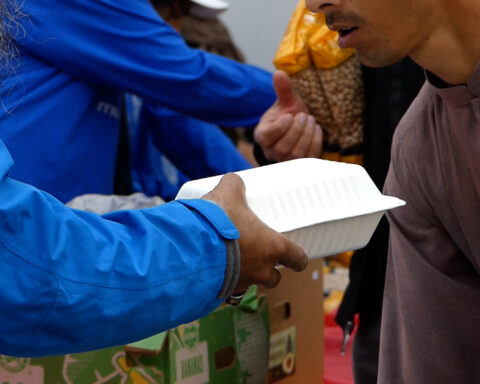
Conservative party members like Minister Jason Kenney (left) have made in-roads with new Canadians in recent years by promoting the value of multiculturalism and attending cultural events like the Khalsa Day Parade. But, experts ask, will that be enough to earn their vote this October?
Photo Credit: Jason Hargrove via Flickr CC
Heading into this federal election campaign, the Liberal Party of Canada finds itself on unfamiliar terrain.
After having held power for 70 years in the 20th century and acquiring the sobriquet of Canada’s Natural Governing Party, most recent opinion polls place it third in the race.
Alongside the Liberals, many immigrant voters too find themselves in a strange position this time around.
Since the 1970s, the early days of Canada’s modern immigration regime, it has been a virtual truism to observe that new Canadian voters belong to the Liberal Party.
Since the 1970s, the early days of Canada’s modern immigration regime, it has been a virtual truism to observe that new Canadian voters belong to the Liberal Party.
This has been so for a range of reasons (some more speculative than others) from the Pearson Liberals’ introduction of the points system in 1967 to Pierre Elliot Trudeau’s stewardship of Canadian multiculturalism in the 1970s.
The Reform Party’s perceived hostility toward “hyphenated” immigrant citizens in the late 1980s and 1990s also helped in cementing their bond with the Liberals.
As immigration numbers climbed, new Canadians became an increasingly important and historically reliable source of support for the Liberals, who, more often than not, were number one in federal elections.
It all changed with the 2011 election. The Conservatives won their first majority and made significant inroads into the new Canadian communities long beholden to the Liberals. Why did more than three decades’ worth of relatively consistent support decline?
Conservative success an aberration?
One answer might be that since 2004 the Conservatives recognized the necessity of appealing to new Canadians.
They developed targeted research to identify cultural groups amenable to their social and fiscal conservatism, attended innumerable religious and cultural festivals nationwide, loudly proclaimed the value of multiculturalism, maintained robust annual immigration quotas, issued apologies for historical harms to certain communities, and, of course, tweeted photographs of MPs in turbans.
In short, the Conservatives have done exactly what worked for the Liberals: they have built a presence in communities, issued policies and symbolic gestures favourable to them, drawn MPs from their ranks, and embraced the national diversity to which they contribute. By all accounts, it seems to have worked.
But, then again, maybe not. The Conservatives’ successes, and Liberals’ failures, might be more of an aberration than an indication of any larger or longer-term trend.
[T]he Conservatives have aggressively pursued policies whose substance and rhetoric could very easily alienate new Canadians.
The Liberals were at a historic low point by the time of the last election. After reaching unprecedented depths with only 26 per cent of the vote in 2008, they hit rock bottom, capturing just under 19 per cent of the vote in 2011. It is hardly surprising that a party so unpopular among voters in general would lose the backing of some of its core supporters.
However, even though fewer immigrant Canadians voted Liberal in 2011, many more still said they thought of themselves as Liberals. And there is some evidence that they were returning to the fold as early as 2012. In addition to this, the Conservatives have aggressively pursued policies whose substance and rhetoric could very easily alienate new Canadians.
The climate of fear-mongering surrounding Bill C-51 and Bill S-7 (Zero Tolerance for Barbaric Cultural Practices Act) has proven unpalatable to many Canadians, and appears to target Canada’s Muslim communities.
This perceived hostility toward Muslim Canadians has only been further exacerbated by Stephen Harper’s declamation against the niqab as “rooted in a culture that is anti-women” and by his dogged determination to keep Omar Khadr incarcerated, despite the Supreme Court’s judgment to the contrary.
The Conservatives have also, in the last few years, eroded the rights of dual citizens. Bill C-24 empowers the government to strip them of their Canadian passport for certain offences.
This legislation eradicates the equality of citizenship (Canadians without a second nationality remain subject to our legal system, while dual citizens can be pushed out of it) and opens the possibility that Canadian-born subjects could be extradited to a country to which they’ve never been, and whose language they might not even speak.
NDP in the forefront
Finally, there is the matter of the three-way race that the New Democratic Party’s rise has opened up. With a weaker Liberal Party, will new Canadians take a closer look at the NDP as an alternative?
Overlooked in hype around the Conservatives’ efforts to win the support of new Canadians is the NDP’s outreach among minority ethno-cultural communities for decades.
A survey of federal party memberships as far back as the year 2000 indicated that it was the NDP, rather than the Liberals, who stood out with approximately one in five members born outside of Canada. While the NDP’s efforts with new Canadians haven’t always paid off at the ballot box in the past, things may be different now that they are the official opposition.
Can the Liberal Party win back the support of new Canadian voters, or will it be overtaken by a surging NDP?
The 2015 election thus raises a number of interesting questions: Can the Liberal Party win back the support of new Canadian voters, or will it be overtaken by a surging NDP? Can the Conservative Party of Canada hold onto the gains it made in 2011, or will its policies on citizenship, the niqab and national security turn a significant segment of new Canadian voters away?
What combination of outreach, ideology and appeals to material interests will garner the parties an advantage with new Canadian voters while maintaining and extending their appeal to other important constituencies?
One thing is for certain: Given their large numbers, clustering in vote rich urban regions and tendency to vote at the same rate as native-born, new Canadians will be aggressively courted by all three parties. Stay tuned as we track how parties compete for their support in the weeks ahead. We’re in for a long and interesting campaign.
Inder S. Marwah is a SSHRC Postdoctoral Fellow at McMaster University’s department of political science. Stephen E. White is a SSHRC Postdoctoral Fellow at Concordia University’s department of political science. Phil Triadafilopoulos is associate professor of political science at the University of Toronto Scarborough and the School of Public Policy and Governance.




